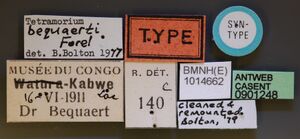Tetramorium bequaerti
| Tetramorium bequaerti | |
|---|---|

| |
| Scientific classification | |
| Kingdom: | Animalia |
| Phylum: | Arthropoda |
| Class: | Insecta |
| Order: | Hymenoptera |
| Family: | Formicidae |
| Subfamily: | Myrmicinae |
| Tribe: | Crematogastrini |
| Genus: | Tetramorium |
| Species: | T. bequaerti |
| Binomial name | |
| Tetramorium bequaerti Forel, 1913 | |
| Synonyms | |
| |
Nothing is known about the biology of Tetramorium bequaerti.
Identification
Bolton (1980) - Of the four species of the bequaerti-complex, characterized by their possession of standing hairs on the scapes and tibiae, T. bequaerti is easily separated from the other three (Tetramorium bulawayense, Tetramorium hortorum, Tetramorium xuthum) by its larger size, short blunt pilosity, and especially by the presence in T. bequaerti of a prominent lobe or lug at the lower occipital corner, not seen in related species.
Keys including this Species
Distribution
Distribution based on Regional Taxon Lists
Afrotropical Region: Democratic Republic of Congo (type locality), United Republic of Tanzania.
Distribution based on AntMaps
Distribution based on AntWeb specimens
Check data from AntWeb
Countries Occupied
| Number of countries occupied by this species based on AntWiki Regional Taxon Lists. In general, fewer countries occupied indicates a narrower range, while more countries indicates a more widespread species. |

|
Estimated Abundance
| Relative abundance based on number of AntMaps records per species (this species within the purple bar). Fewer records (to the left) indicates a less abundant/encountered species while more records (to the right) indicates more abundant/encountered species. |

|
Biology
Castes
Worker
Images from AntWeb
   
| |
| Syntype of Tetramorium bequaerti. Worker. Specimen code casent0901248. Photographer Will Ericson, uploaded by California Academy of Sciences. | Owned by NHMUK, London, UK. |
Nomenclature
The following information is derived from Barry Bolton's Online Catalogue of the Ants of the World.
- bequaerti. Tetramorium bequaerti Forel, 1913b: 318 (w.) DEMOCRATIC REPUBLIC OF CONGO. Senior synonym of humile: Bolton, 1980: 325.
- humile. Tetramorium humile Santschi, 1914a: 434 (w.q.) TANZANIA. Junior synonym of bequaerti: Bolton, 1980: 325.
Unless otherwise noted the text for the remainder of this section is reported from the publication that includes the original description.
Description
Worker
Bolton (1980) - TL 4.3-4.6, HL 0.98-1.05, HW 0.84-0.90, CI 85-87, SL 0.90-0.94, SI 104-106, PW 0.66-0.70, AL 1.28-1.32 (5 measured).
Mandibles strongly longitudinally striate. Anterior clypeal margin entire, without trace of a median notch. Median clypeal carina strongly developed. Frontal carinae short and vestigial, at most extending back to level of midlengths of eyes, generally shorter; frontal carinae always very fine, sometimes indistinct except for immediately behind the frontal lobes. Antennal scrobes absent. Scapes long, SI > 100. Eyes moderate, maximum diameter 0.21-0.24, about 0.23-0.26 x HW. With the head in profile the lower occipital corner strongly projecting into a blunt lobe or lug which at its apex is about as broad as the maximum eye diameter. Propodeum armed with a pair of elongate spines, the metapleural lobes broadly triangular, elongate and running roughly parallel to the propodeal spines, which are narrower. Petiole node in profile elongate, rectangular, the dorsal length greater than the height of the tergal portion. In dorsal view the node longer than broad. Dorsum of head feebly sculptured, usually only with a sparse superficial punctulation or granulation, sometimes also with a few weak longitudinal striae. Sides of head in front of and below eyes with fine rugular sculpture, reticulate in places. Dorsal alitrunk with fine, delicate longitudinal striae or rugulae and with a fine, fairly dense but superficial punctulate-granular groundsculpture. Petiole and postpetiole with same ground-sculpture as is seen on alitrunk but with a stronger rugular component also present which may form meshes on the sides and dorsum. First gastral tergite finely punctulate-shagreened everywhere. All surfaces of head and body and all surfaces of scapes, femora and tibiae with abundant short, blunt, erect to suberect stout hairs. Colour dull red.
Type Material
Bolton (1980) - Syntype workers, ZAIRE: Katanga, Lake Kabwe, 16.vii.1911 (Bequaert) (Musee Royal de I' Afrique Centrale; Musee d'Histoire Naturelle Genève) [examined]. Syntype worker, female, TANZANIA: Morogoro (Naturhistorisches Museum, Basel) [female examined].
References
- Bolton, B. 1980. The ant tribe Tetramoriini (Hymenoptera: Formicidae). The genus Tetramorium Mayr in the Ethiopian zoogeographical region. Bulletin of the British Museum (Natural History) Entomology. 40(3):193-384.
- Forel, A. 1913b. Formicides du Congo Belge récoltés par MM. Bequaert, Luja, etc. Rev. Zool. Afr. (Bruss.) 2: 306-351 (page 318, worker described)

